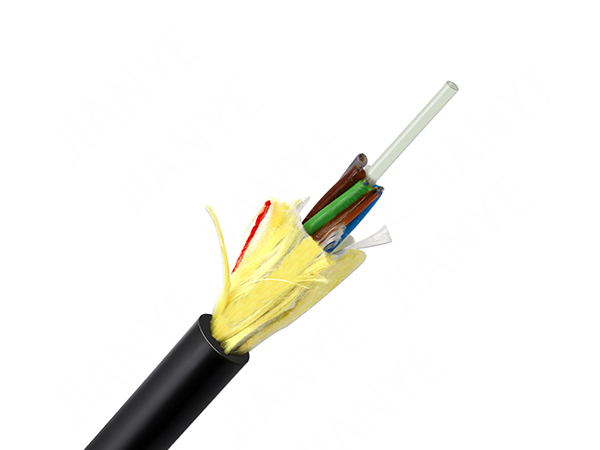The 6 core ADSS cable (
All-Dielectric Self-Supporting Cable) is a critical innovation in the field of fiber optic communications, offering a robust and versatile solution for high-speed data transmission in challenging environments. Designed for aerial installations without the need for metallic support structures, this cable type is widely adopted in power utilities, telecommunications, and smart grid systems. This article GL FIBER explores the technical features, applications, and advantages of the 6 core ADSS cable.

Structure and Design:
The 6 core ADSS cable integrates six optical fibers within a lightweight, fully dielectric design. Key structural components include:
1. Optical Fibers: Six single-mode or multimode fibers arranged in a compact, protective buffer tube.
2. Strength Members: High-tensile aramid yarns (e.g., Kevlar) provide mechanical reinforcement to withstand tension and environmental stress.
3. Outer Sheath:
Dual-layer polyethylene (PE) or AT (Anti-Tracking) sheath ensures resistance to UV radiation, moisture, and electrical arcing, critical for installations near high-voltage power lines.
4. Dielectric Construction: The absence of metallic components eliminates electromagnetic interference (EMI) risks, making it ideal for co-installation with power transmission infrastructure.
Key Advantages:
Self-Supporting Capability: Engineered for aerial deployment, the 6 core
ADSS cable eliminates the need for messenger wires or separate support structures, reducing installation time and costs.
High Durability: With a tensile strength exceeding 30 kN and a temperature operating range of -40°C to +70°C, it performs reliably in extreme weather conditions.
EMI Immunity: Its all-dielectric design ensures stable signal transmission even in proximity to high-voltage power lines.
Low Maintenance: Resistant to corrosion, rodent damage, and chemical exposure, the cable ensures long-term reliability with minimal upkeep.
Applications:
Power Utilities: Widely used for optical ground wire (OPGW) communication networks, enabling real-time monitoring and control of power grids.
Telecom Networks: Deployed in rural and urban aerial networks to expand broadband connectivity.
Smart Grids: Facilitates data exchange for grid automation, renewable energy integration, and fault detection.
Railways and Transportation: Supports communication systems for signaling and safety applications.
Installation Considerations:
Span Length: Typically supports spans up to 1,500 meters, depending on sag and tension calculations.
Clearance Requirements: Must comply with safety standards for proximity to power lines and ground obstacles.
Sag-Tension Analysis: Pre-installation engineering ensures optimal performance under wind and ice loads.
Compliance and Standards:
The 6 core ADSS cable adheres to international standards, including:
IEC 60794 (Optical fiber cables)
IEEE 1138 (Installation guidelines for ADSS cables)
ANSI/ICEA S-87-640 (Mechanical and environmental performance)

Conclusion:
The
6 core ADSS cable represents a cost-effective, high-performance solution for modern fiber optic networks, combining durability, ease of installation, and immunity to electromagnetic disturbances. As demand for reliable, high-bandwidth communication grows, its role in power and telecom infrastructure will continue to expand, solidifying its position as a cornerstone of next-generation connectivity.


